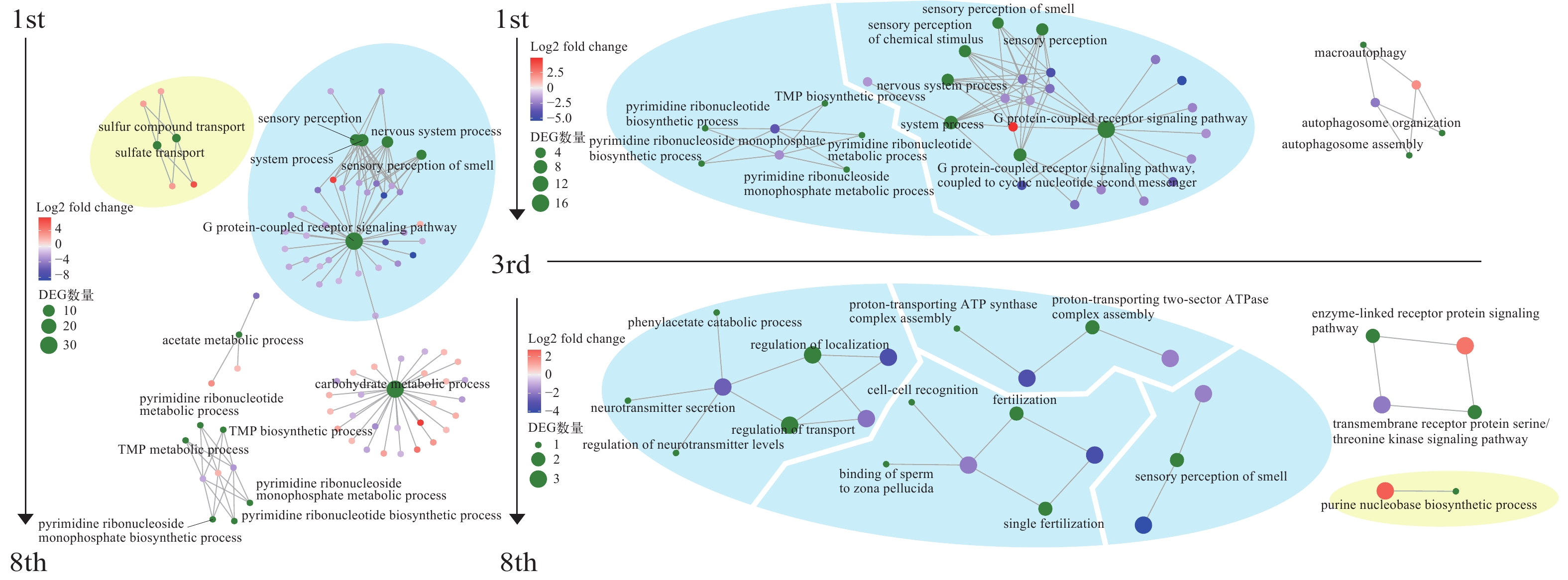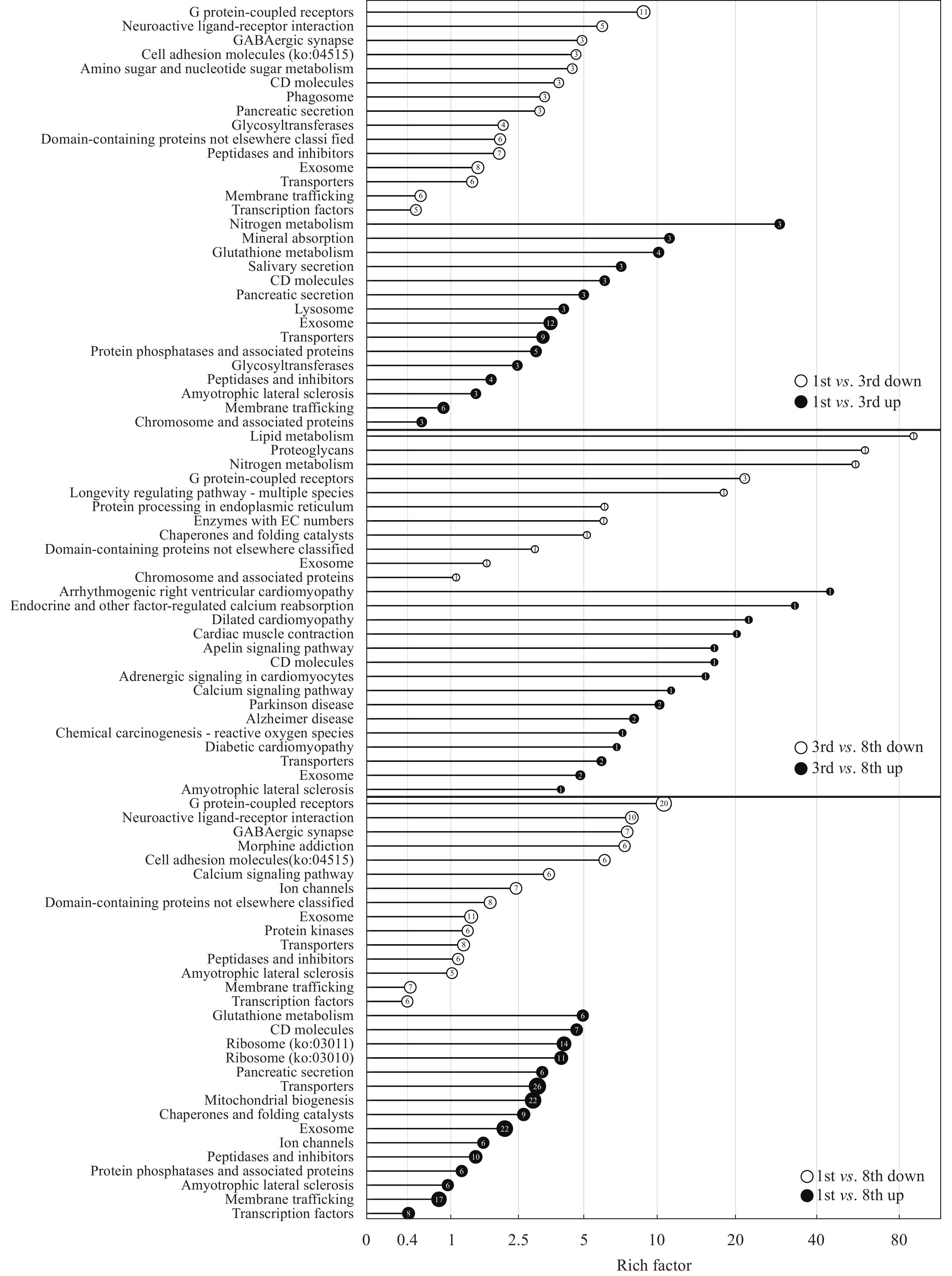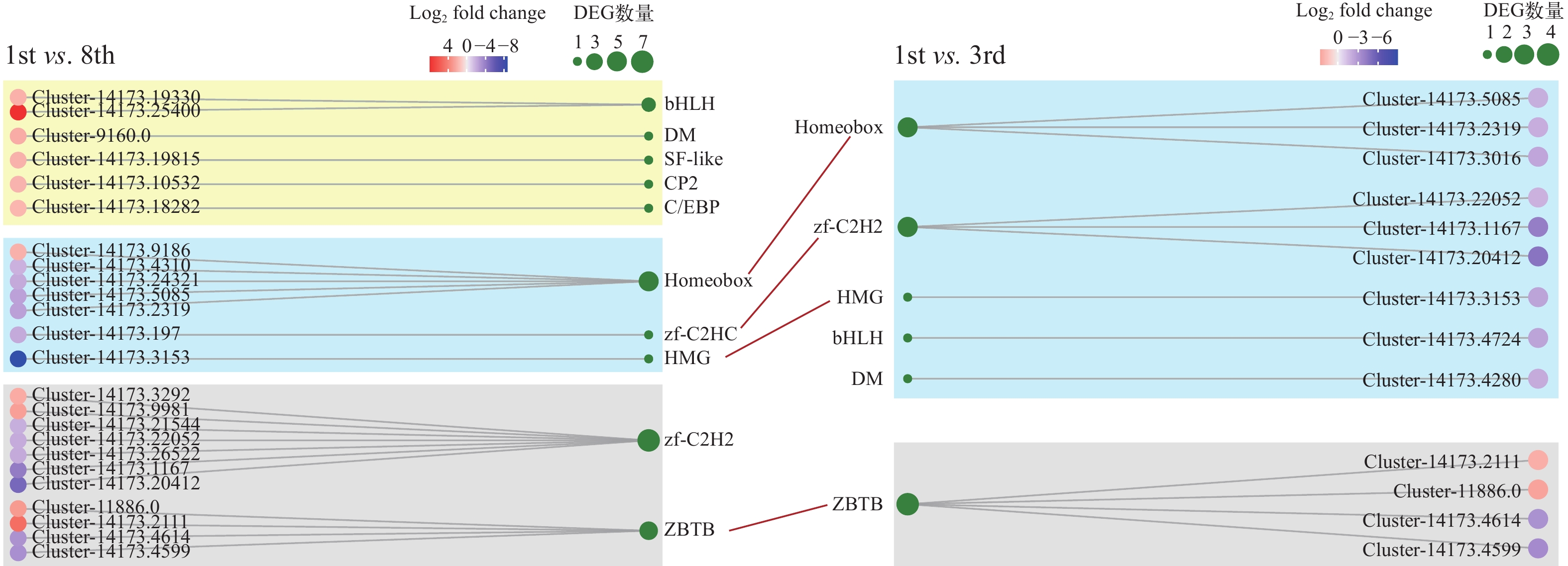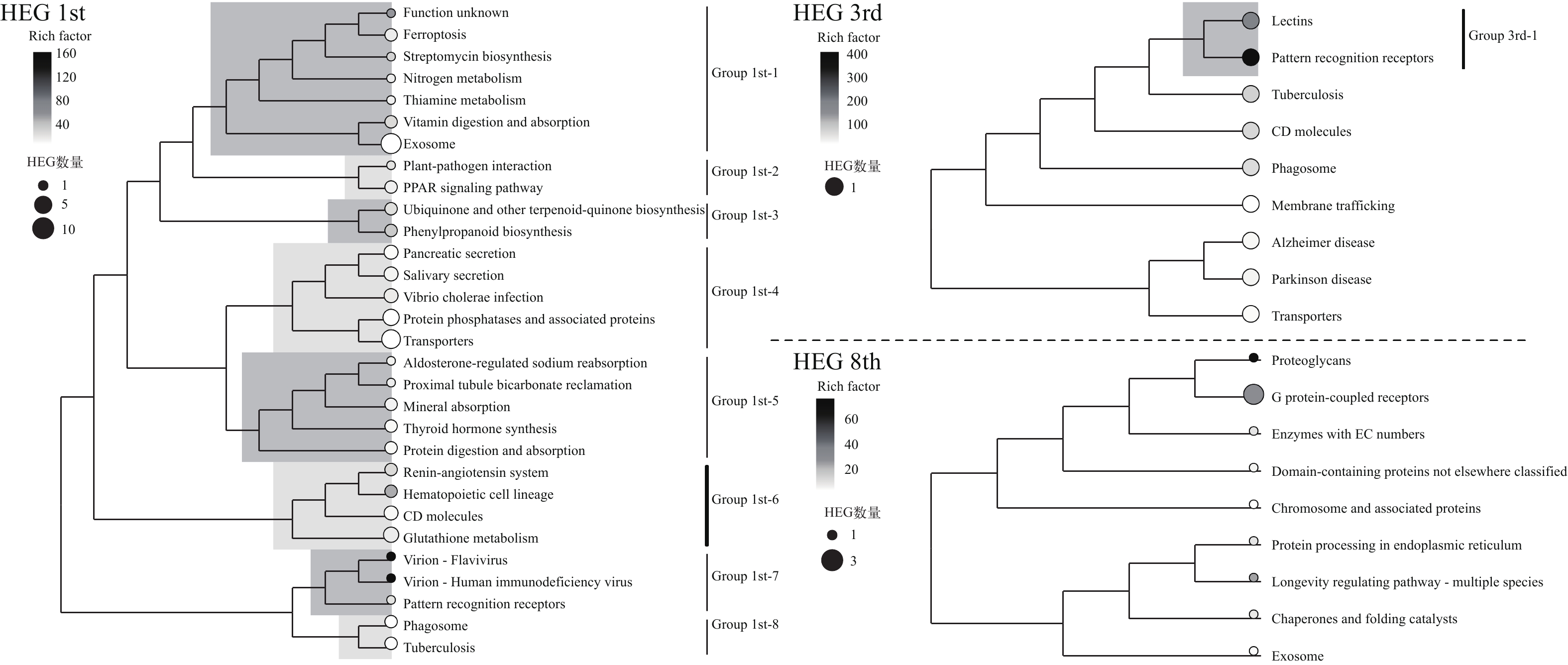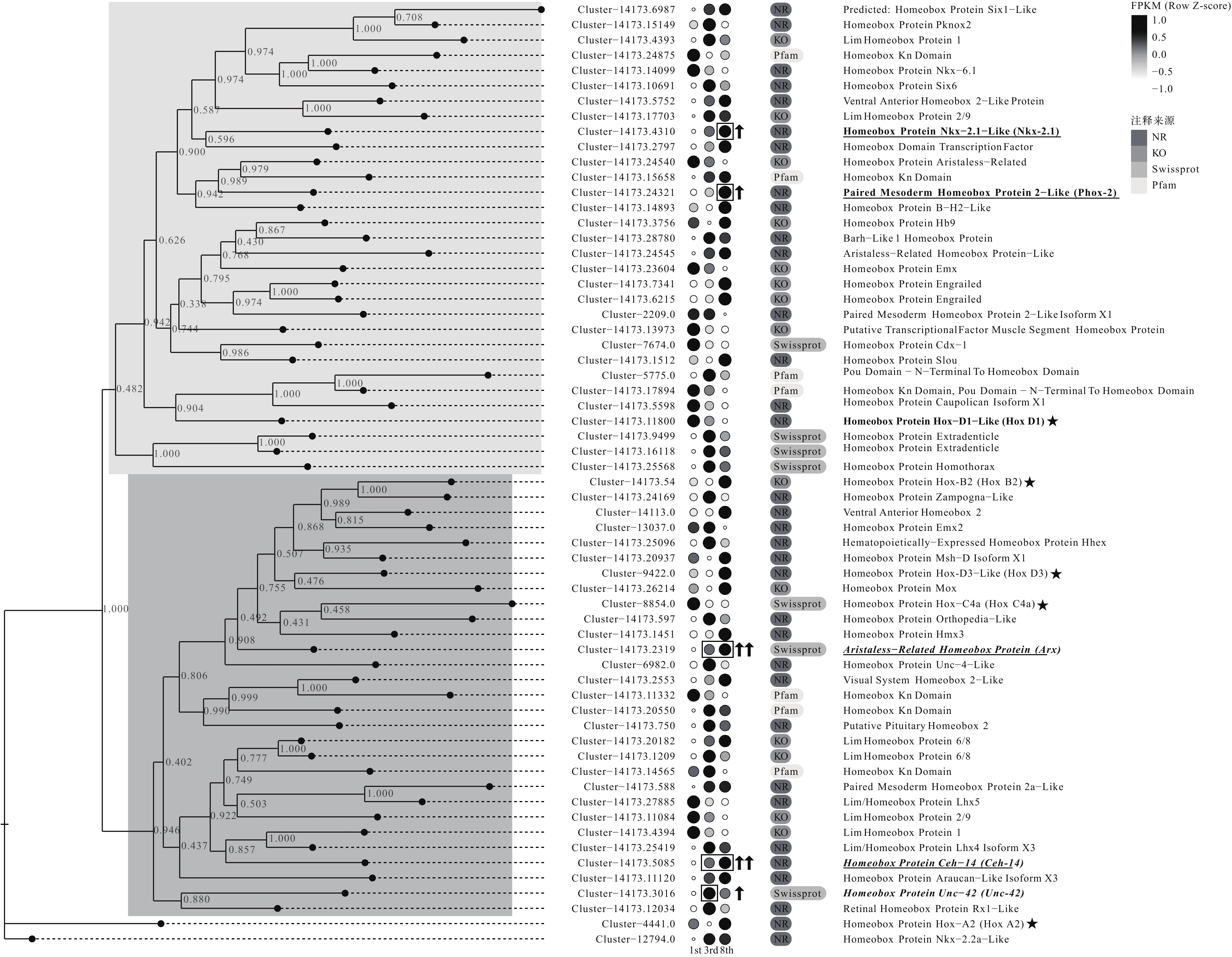POTENTIAL REGULATORY ROLES OF G PROTEIN-COUPLED RECEPTORS AND HOMEOBOX GENES IN THE CEREBRAL GANGLION OF ARTEMIA DURING EARLY DEVELOPMENT
-
摘要:
为揭示卤虫变态发育过程中的神经调控机制, 研究报告了孤雌生殖卤虫三个典型发育阶段脑神经节的转录动态, 鉴定了各阶段特异表达的基因并预测了其功能。结果表明: 第1龄期的高表达基因(HEG)涉及大量的有机物代谢和免疫调节, 如含硫化合物转运及鸟氨酸代谢; 第3龄期的HEGs与细胞呼吸、甲基化和嘌呤代谢相关; 第8龄期的HEGs涉及神经信号传递和细胞间识别。其中, G蛋白偶联受体(GPCR)和homeobox基因在第3和第8龄期显著高表达, 继而探讨这些基因的亚家族表达特征及功能, 如视蛋白受体、神经活性配体受体和嗅觉受体这类GPCRs在幼体发育的相对后期阶段显著高表达, homeobox基因家族中的Unc-42、Arx和Ceh-14在第3龄期高表达, Arx、Ceh-14、Nkx2和Phox在第8龄期高表达。总之, 第1龄期幼体通过增强代谢和物质运输来支持其快速生长, 第3龄期到第8龄期是细胞分化和神经系统成熟的关键阶段, GPCR和homeobox的高表达提示卤虫视觉发育及神经系统的进一步特化。研究不仅提供了一组脑神经节转录组数据, 还为认识卤虫的发育机制及深入理解神经调控在甲壳动物变态发育过程中的作用提供了新线索。
Abstract:Artemia, a small aquatic crustacean widely distributed in saline and alkali environments, represents as a valuable model for investigating gene regulation mechanisms in crustacean development. Under favorable conditions, Artemia larvae, complete metamorphosis through multiple molts within 2—4 weeks, but the neural regulation mechanisms involved in individual development are currently unclear. This study reports on the transcriptional dynamics of the cerebral ganglia across three developmental stages, identifying genes specifically expressed at each stage and predicting their functions. In the instar I stage, highly expressed genes (HEGs) are primarily involved in the metabolism of organic compounds and immune regulation, including sulfur compound transport and ornithine metabolism. In instar Ⅲ, HEGs are related to cellular respiration, methylation, and purine metabolism, while in instar Ⅷ, they are associated with neural signal transmission and cell-cell recognition. Notably, G protein-coupled receptors (GPCRs) and homeobox genes are significantly highly expressed in the instar Ⅲ and instar Ⅷ stages. The functions of these gene subfamilies were further explored: GPCRs, such as opsin receptors, neuroactive ligand receptors, and olfactory receptors, are highly expressed in the relatively later stages of larval development. Homeobox genes, including Unc-42, Arx, and Ceh-14 are highly expressed in instar Ⅲ stage, while Arx, Ceh-14, Nkx2, and Phox are highly expressed in instar Ⅷ stage. The results indicate that instar Ⅰ larvae grow efficiently by enhancing metabolism and substance transport, while instar Ⅲ to Ⅶ is an important stage for cell differentiation and nervous system maturation. The increased expression of GPCRs and homeobox genes during this time points to further visual development and nervous system specialization in Artemia. This study provides a comprehensive transcriptome dataset of cerebral ganglion and offers insights into the developmental mechanisms of Artemia, shedding light on the neural regulatory roles in crustacean development.
-
Keywords:
- Development /
- Cerebral ganglion /
- G protein-coupled receptors /
- Homeobox /
- Artemia
-
甲壳类动物是水生生态系统的重要组成部分, 它们根据自身需求生活在不同的栖息地, 并可作为碎屑者或营养循环者发挥生态作用[1]。甲壳动物的变态发育多种多样, 在一些物种中胚胎外的自由幼虫(或幼体)阶段非常短暂甚至不存在[2], 如红鳌螯虾(Cherax quadricarinatus)经历直接发育过程, 幼体在孵化时已具有相对完整的形态[3]; 而在另一些生物如水蚤(Daphnia)[4—6]中, 幼体阶段延长, 期间完成一系列蜕皮过程并发生形态变化。蜕皮是动物通过替换硬化的旧外骨骼并硬化新形成的更大外骨骼来生长的循环过程, 这不仅是增加体积的手段, 还可促进附肢和体节的形成, 在变态发育中具有重要作用[7—9]。
自2010年以来, 转录组测序技术对甲壳动物研究产生重大影响, 已广泛应用于甲壳动物的鳃[10—13]、肝胰腺[13, 14]和肌肉[12, 15]等组织的分析。其中, 基于神经转录组的研究表明, 神经调控在个体发育的复杂过程中可能发挥了重要作用, 如蚤状溞(Daphnia pulex)[4]、三疣梭子蟹(Portunus trituberculatus)[16]、美洲螯龙虾(Homarus americanus)[17—19]、克氏原螯虾(Procambarus clarkii)[20, 21]、东岩龙虾(Sagmariasus verreauxi)[22]、鱼虱(Caligus rogercresseyi)[23, 24]和沼虾属(Macrobrachium)[25, 26]眼柄上的神经通过产生甲壳类高血糖激素(CHH)、甲壳类心脏活性肽(CCAP)、羽化激素和色素分散激素(PDH)等神经激素调节蜕皮、繁殖、表皮色彩图案和渗透作用。甲壳动物还可通过眼柄神经分泌的蜕皮抑制激素(MIH)与Y器官细胞膜上的受体结合, 激活环鸟苷酸(cGMP)或环腺苷酸(cAMP)信号通路, 抑制蜕皮激素合成酶表达与活性, 进而调控蜕皮周期[27]; 眼柄神经分泌的卵黄发生抑制激素(VIH)则通过抑制卵黄蛋白的合成来调节其繁殖周期[28]。此外, 基于免疫组化的研究表明, 藤壶(Balanus amphitrite)幼虫阶段的外周神经系统和非神经结构中存在N-甲基-D-天冬氨酸(NMDA)样免疫反应性, 这表明NMDA受体通过神经调控在肌肉控制中发挥作用[29]。目前, 关于神经系统在甲壳动物发育过程中的调控机制, 以及神经调控在各发育阶段适应性行为中的作用仍不清楚, 已有的甲壳动物神经相关组学资源较为有限, 因此有必要通过深入的组学研究来揭示神经系统的发育过程, 以进一步理解甲壳动物特殊的生命现象和生理过程。
卤虫(Artemia), 又称丰年虾或盐水虾, 隶属于甲壳亚门鳃足纲卤虫属, 是一种适于生活在高盐环境中的小型水生甲壳类动物, 其幼体从孵化到首次繁殖的时间适中(约30d), 并表现出一种涉及多个龄期的变态发育模式[30—32], 可作为研究甲壳动物发育过程的潜在模式生物。孤雌生殖卤虫(Artemia parthenogenetica)无需受精便可通过产幼或产卵的方式繁殖后代, 可在实验室中作为遗传一致的克隆系进行培养, 为分析单一基因在整个发育过程中的转录变化提供可靠材料。本研究使用Illumina高通量测序技术, 对孤雌生殖卤虫第1、3和8龄期[30]三个典型发育阶段的脑神经节转录组进行采样, 分析每个阶段的高表达基因, 预测这些基因的功能模块, 并对阶段特异性表达的G蛋白偶联受体(GPCR)和homeobox基因亚家族进行划分。本研究结果为卤虫发育过程中的基因表达模式提供了新的见解, 并强调了支撑其幼体发育阶段的重要基因和途径。
1. 材料与方法
1.1 实验材料
对新疆艾比湖的孤雌生殖卤虫卵进行孵化培养, 以发育早期的卤虫为研究对象。在28℃、35 g/L盐度、2000 lx光照(光周期为12L﹕12D)和连续充气的条件下培养, 分别收集第1、第3和第8龄期幼体[30], 并将其置于0℃条件下的冰板, 使用体式镜解剖得到脑神经节组织并收集到无酶管中(每组200只), 用液氮速冻处理后储存于–80℃冰箱中。
1.2 RNA提取、文库构建与测序
对上述卤虫组织样品进行总RNA提取(TRIzol法), 检测RNA质量后, 将符合要求的样品放置于–80℃冰箱保存。使用PrimeScript RT reagent Kit with gDNA eraser试剂盒(TaKaRa)将RNA样品反转录为cDNA, 后由诺禾致源(天津)公司进行质控、文库构建及测序, 测序平台为Illumina NovaSeq 6000。
1.3 从头组装与功能注释
使用Trinity[33]对质控后的clean reads进行de novo组装, 获得全基因组转录本, 使用Corset[34]对转录本进行层次聚类获得对应的cluster作为参考基因, 将每个参考基因中最长的转录本作为该基因的unigene。在获得拼接转录本后, 使用Diamond[35] (e-value = 1e-5, more-sensitive)进行Nr、KOG和Swiss-Prot数据库注释, 使用NCBI BLAST[36] (e-value = 1e-5)进行Nt数据库注释。使用HMMER 3.0 (hmmscan e-value = 0.01)进行Pfam数据库注释。使用KEGG Automatic Annotation Server[37] (e-value = 1e-10)进行KEGG数据库注释。基于NR和Pfam的蛋白注释结果, 使用Blast2GO v2.5[38](e-value = 1e-6)进行GO数据库注释。使用hmmsearch基于animalTFDB 2.0数据库中转录因子家族的Pfam文件对转录因子进行注释。
1.4 表达定量与差异分析
使用RSEM[39]软件的Bowtie2将各样品的clean reads与去冗余后的最终参考基因(unigenes)进行比对并统计, 获得read count表达矩阵及标准化后的fpkm表达矩阵[40]。使用edgeR[41]计算每两个样本间的log2 fold change值及P-value值, 对P-value进行多重假设检验校正(Benjamini-Hochberg方法)后获得padj (FDR)值, 差异表达基因的筛选阈值为| log2 fold change |>1 且 padj<0.005。
1.5 富集分析
使用R包AnnotationForge分别对KEGG和转录因子注释结果进行打包, 使用R包clusterProfiler[42] (minGSSize=1)对基因集进行GO、KEGG和转录因子富集分析。在大多数非经典模式生物中, 如孤雌生殖卤虫, 基因集富集分析的能力可能有限, 这主要是因为功能注释只适用于所分析基因的一部分。
1.6 系统发育分析
使用muscle软件对homeobox转录本进行多序列比对, 将结果输入PhyloSuite[43]软件, 使用ModelFinder工具计算构建贝叶斯系统发育树的最佳参数, 使用该参数通过MrBayes工具构建系统发育树。
2. 结果
2.1 不同发育阶段脑神经节的基因表达特征
第1、第3和第8龄期三个阶段孤雌生殖卤虫的发育表型和脑神经节转录动态如图 1 所示。第1龄期幼体无明显分节, 头部中央有一红色单眼; 第3龄期幼体刚开始出现体节与乳状突起, 正在形成复眼; 第8龄期幼体已初步形成副肢, 复眼处刚生长出眼柄(图 1A)。质控后平均每个样本获得20153560 clean reads (表 1), 使用Trinity软件组装后获得83594个transcripts, 去冗余后获得44694个unigenes (图 1B)。对fpkm进行对数转换和标准化后的表达热图显示, 三个发育阶段的基因表达模式存在明显差异(图 1C)。通过对每两个样本间的差异表达基因(DEG)进行鉴定, 分别获得198、32和485个在前者高表达的基因及332、186和740个在后者高表达的基因, 这6个基因集中1st vs. 3rd down与1st vs. 8th down之间存在最多的共有基因(图 1D), 表明第3和第8龄期的基因表达模式更为相似, 与表达热图的趋势相同。
![]() 图 1 孤雌生殖卤虫发育过程中脑神经节的基因表达特征A. 第1、3和8龄期卤虫幼体形态; B. Transcripts和unigenes的长度分布, transcripts代表无参组装得到的所有转录本序列, unigenes为所有转录本聚类和去冗余后的最终参考基因; C. 样本间基于fpkm值的相关性分析热图(上)及fpkm值标准化后的表达谱热图(下); D. 各发育阶段比较组的差异表达基因数量柱状图和相互关系弦图Figure 1. The gene expression signature of cerebral ganglion during the development of A. parthenogeneticaA. Morphological images of the instar Ⅰ, instar Ⅲ, and instar Ⅷ larvae of Artemia; B. Length distribution of transcripts and unigenes, where transcripts represent all assembled transcript sequences from the de novo assembly, and unigenes are the final reference genes obtained by clustering and deduplication of all transcripts; C. Heatmap of sample correlation analysis based on fpkm values (top) and expression profile heatmap after fpkm value normalization (bottom); D. Bar plot showing the number of differentially expressed genes across developmental stage comparisons and chord diagram representing their interrelationships表 1 样本测序数据汇总Table 1. Summary of sample sequencing data
图 1 孤雌生殖卤虫发育过程中脑神经节的基因表达特征A. 第1、3和8龄期卤虫幼体形态; B. Transcripts和unigenes的长度分布, transcripts代表无参组装得到的所有转录本序列, unigenes为所有转录本聚类和去冗余后的最终参考基因; C. 样本间基于fpkm值的相关性分析热图(上)及fpkm值标准化后的表达谱热图(下); D. 各发育阶段比较组的差异表达基因数量柱状图和相互关系弦图Figure 1. The gene expression signature of cerebral ganglion during the development of A. parthenogeneticaA. Morphological images of the instar Ⅰ, instar Ⅲ, and instar Ⅷ larvae of Artemia; B. Length distribution of transcripts and unigenes, where transcripts represent all assembled transcript sequences from the de novo assembly, and unigenes are the final reference genes obtained by clustering and deduplication of all transcripts; C. Heatmap of sample correlation analysis based on fpkm values (top) and expression profile heatmap after fpkm value normalization (bottom); D. Bar plot showing the number of differentially expressed genes across developmental stage comparisons and chord diagram representing their interrelationships表 1 样本测序数据汇总Table 1. Summary of sample sequencing data样本名称
Name原始Reads 质控后Reads 错误率
Error rate (%)Q20 (%) Q30 (%) GC含量
GC percentage (%)Unigene比对率
Mapped to unigenes (%)1st 21463430 20153560 0.03 97.01 92.03 39.11 85.56 3rd 21617734 20742657 0.03 97.31 92.75 39.27 84.85 8th 23498595 22545548 0.03 96.62 91.2 39.19 83.63 2.2 功能注释
通过多个数据库对unigenes进行功能注释(表 2), 其中17501个(39.15%) unigenes至少被1个数据库注释, 1378个(3.08%) unigenes被7个主要数据库注释, 被NR、GO和KEGG注释的unigenes分别为12751、12077和7213个。此外, 转录因子(AnimalTFDB数据库)和互作蛋白(STRING数据库, 参考物种为Daphnia magna)的注释结果分别为1030和7230个。
表 2 基因注释统计结果Table 2. Statistical results of gene annotation数据库
DatabaseUnigene数量
Number of Unigenes比例Percentage(%) NR 12751 28.52 GO 12077 27.02 KEGG 7213 16.13 NT 3700 8.27 KOG 5572 12.46 SwissProt 9712 21.72 PFAM 12309 27.54 至少被以上1个数据库注释 17501 39.15 被以上7个数据库注释 1378 3.08 其他数据库: AnimalTFDB 1030 2.30 其他数据库: STRING 7230 16.18 Unigene总数 44694 100 2.3 差异表达基因富集分析
分别对每两组样本的上调和下调DEGs进行了GO富集分析, 选取拥有unigenes最多的前15个通路或功能绘制网络图(图 2)。结果显示, 第1与第8龄期相比, 第1龄期中的高表达DEGs主要涉及硫酸盐及含硫化合物的转运, 第8龄期中的高表达DEGs主要涉及感官感知、嗅觉感知、神经系统过程和G蛋白偶联受体信号传导, 而富集到碳水化合物代谢等功能的DEGs既有在第1龄期中高表达的, 也有在第8龄期中高表达的; 第1与第3龄期相比, 富集度最高的功能或通路中的DEGs主要表现为下调, 即在第3龄期中高表达, 其涉及与系统过程和G蛋白偶联受体信号传导相关的感官感知(嗅觉感知和化学刺激感知)及嘧啶核苷酸(TMP)生物合成过程; 第3与第8龄期相比, 第8龄期中的高表达DEGs大量富集到细胞代谢及调控(苯乙酸降解、定位调控、转运调控、神经递质分泌及调控)、细胞能量代谢相关的复合体装配(质子转运ATP合酶和双扇区ATP酶复合体组装)、生殖相关细胞的识别和相互作用(细胞间识别、单一受精和精子与透明带结合)及嗅觉感知, 而第3龄期中的高表达DEGs则与嘌呤碱基合成相关。
![]() 图 2 差异表达基因GO富集结果红色/蓝色节点代表在前者/后者中差异高表达的unigenes, 绿色节点代表通路或功能, 连线表示二者存在相互关系; 黄色/蓝色区域分别表示其中的unigenes主要在前者/后者中显著高表达Figure 2. GO enrichment results of DEGsRed/blue nodes represent unigenes that are differentially upregulated in the former/latter, green nodes represent pathways or functions, and the connections indicate relationships between them; The yellow/blue areas highlight unigenes that are predominantly upregulated in the former/latter
图 2 差异表达基因GO富集结果红色/蓝色节点代表在前者/后者中差异高表达的unigenes, 绿色节点代表通路或功能, 连线表示二者存在相互关系; 黄色/蓝色区域分别表示其中的unigenes主要在前者/后者中显著高表达Figure 2. GO enrichment results of DEGsRed/blue nodes represent unigenes that are differentially upregulated in the former/latter, green nodes represent pathways or functions, and the connections indicate relationships between them; The yellow/blue areas highlight unigenes that are predominantly upregulated in the former/latter对上调和下调DEGs分别进行KEGG富集, 从中选出富集因子前15的KEGG三级通路如图 3 所示(气泡内的数字表示富集到该通路的unigenes数量)。
![]() 图 3 差异表达基因KEGG富集结果横轴表示该通路的富集因子, 气泡大小表示富集到该通路的unigenes数量, 黑色/白色用于区分该比较组中前者/后者差异高表达基因集的富集结果Figure 3. KEGG enrichment results of DEGsThe x-axis represents the rich factor of the pathway, the bubble size indicates the number of unigenes enriched in the pathway, and black/white distinguishes the enrichment results of upregulated gene sets in the former/latter group within the comparison
图 3 差异表达基因KEGG富集结果横轴表示该通路的富集因子, 气泡大小表示富集到该通路的unigenes数量, 黑色/白色用于区分该比较组中前者/后者差异高表达基因集的富集结果Figure 3. KEGG enrichment results of DEGsThe x-axis represents the rich factor of the pathway, the bubble size indicates the number of unigenes enriched in the pathway, and black/white distinguishes the enrichment results of upregulated gene sets in the former/latter group within the comparison进一步对DEGs进行基于转录因子的富集分析(图 4), 结果显示, 第3与第8龄期之间几乎没有差异表达的转录因子(只有1个注释为ZBTB的unigene在第8龄期中高表达), 而第1龄期分别与第3或8龄期相比的结果表现出高相似性。具体来说, 第1龄期和第8龄期相比, 前者中高表达的转录因子为bHLH、DM、SF-like、CP2和C/EBP, 后者中高表达的转录因子为homeobox、zf-C2HC和HMG, zf-C2H2和ZBTB在二者中均存在差异高表达; 第1和3龄期相比, 后者中的高表达转录因子为homeobox、zf-C2H2、HMG、bHLH和DM, ZBTB则在二者中均存在差异高表达。
![]() 图 4 差异表达基因转录因子富集结果红色/蓝色节点代表在前者/后者中差异高表达的unigenes, 绿色节点代表转录因子; 黄色/蓝色区域分别表示其中的unigenes主要在前者/后者中显著高表达Figure 4. Transcription factor enrichment results of DEGsRed/blue nodes represent unigenes that are differentially upregulated in the former/latter and green nodes represent transfactors; The yellow/blue areas highlight unigenes that are predominantly upregulated in the former/latter
图 4 差异表达基因转录因子富集结果红色/蓝色节点代表在前者/后者中差异高表达的unigenes, 绿色节点代表转录因子; 黄色/蓝色区域分别表示其中的unigenes主要在前者/后者中显著高表达Figure 4. Transcription factor enrichment results of DEGsRed/blue nodes represent unigenes that are differentially upregulated in the former/latter and green nodes represent transfactors; The yellow/blue areas highlight unigenes that are predominantly upregulated in the former/latter2.4 高表达基因富集分析
对每个阶段的高表达基因(HEG; 在该样本中的表达量显著高于其他样本; |log2 fold change| >1 & FDR<0.005)进行鉴定, 对这些HEGs进行GO富集分析, 并基于通路或功能富集结果的相关性将其划分为多个模块(图 5)。第1龄期中的155个HEGs涉及糖苷、醇和谷胱甘肽等化合物的合成代谢、葡萄糖等分子的跨膜转运及调节、免疫反应激活及调节和鸟氨酸代谢模块; 第3龄期中的7个HEGs涉及细胞呼吸与电子传递、甲基化相关的催化调节和嘌呤代谢与响应外界刺激模块; 第8龄期中的140个HEGs涉及突触信号释放与神经递质调节、黄曲霉毒素生物合成、甲基化、质子转运ATP合酶复合物组装、受精与细胞间识别、转运与定位调节和神经递质分泌与调节模块。
![]() 图 5 高表达基因GO富集结果左侧为各阶段高表达基因的fpkm值标准化后的表达谱热图; 右侧展示了相应各阶段高表达基因的GO通路或功能的相互关系及模块划分: 节点代表通路或功能, 连线粗细表示两个通路或功能之间共享unigenes的数量, 同一模块中通路或功能的富集结果具有高度相关性Figure 5. GO enrichment results of HEGsThe left panel shows the heatmap of normalized fpkm values for highly expressed genes at each stage, while the right panel displays the relationships and module divisions of GO pathways or functions corresponding to these highly expressed genes. Nodes represent pathways or functions, and the width of the edges indicates the number of shared unigenes between two pathways or functions. Pathways or functions within the same module have highly correlated enrichment results
图 5 高表达基因GO富集结果左侧为各阶段高表达基因的fpkm值标准化后的表达谱热图; 右侧展示了相应各阶段高表达基因的GO通路或功能的相互关系及模块划分: 节点代表通路或功能, 连线粗细表示两个通路或功能之间共享unigenes的数量, 同一模块中通路或功能的富集结果具有高度相关性Figure 5. GO enrichment results of HEGsThe left panel shows the heatmap of normalized fpkm values for highly expressed genes at each stage, while the right panel displays the relationships and module divisions of GO pathways or functions corresponding to these highly expressed genes. Nodes represent pathways or functions, and the width of the edges indicates the number of shared unigenes between two pathways or functions. Pathways or functions within the same module have highly correlated enrichment results对这些HEGs进行KEGG富集, 并基于富集结果相关性对KEGG三级通路进行聚类和分组(图 6)。其中, 第1龄期阶段HEGs富集到的KEGG通路被分为8组, 第3龄期阶段HEGs富集结果中的凝集素和模式识别受体被分为1组, 第8龄期阶段HEGs富集到的KEGG通路之间相关性较弱, 未被分组。
![]() 图 6 高表达基因KEGG富集结果通过Ward.D方法基于富集结果相关性对各阶段高表达基因富集到的KEGG通路进行聚类和分组, 同组内通路具有高相关性Figure 6. KEGG enrichment results of HEGsClustering and grouping of KEGG pathways enriched by HEGs at each stage are performed using the Ward.D method, based on the correlation of enrichment results. Pathways within the same group exhibit high correlation
图 6 高表达基因KEGG富集结果通过Ward.D方法基于富集结果相关性对各阶段高表达基因富集到的KEGG通路进行聚类和分组, 同组内通路具有高相关性Figure 6. KEGG enrichment results of HEGsClustering and grouping of KEGG pathways enriched by HEGs at each stage are performed using the Ward.D method, based on the correlation of enrichment results. Pathways within the same group exhibit high correlation2.5 G蛋白偶联受体基因的功能鉴定
DEG富集分析表明, 与第1龄期相比, G蛋白偶联受体(GPCR)相关基因在第3和8龄期中显著高表达(图 2), 第8龄期阶段HEGs的KEGG富集结果中, GPCR通路拥有最多的DEGs及较高的富集因子(图 6), 因此我们对这些在第3或8龄期中高表达(|log2 fold change|>1 & FDR<0.005)的GPCR基因(被GO或KEGG注释为G蛋白偶联受体的unigenes)的功能或亚类进行进一步鉴定: 将上述unigenes在所有数据库(表 2)中的注释信息进行合并和去重, 并统计来自于这些unigenes的功能。结果表明, 这些在幼体发育相对后期阶段脑神经节中高表达的GPCRs主要包括视蛋白受体(视紫红质、视蛋白BCRH1和视蛋白BCRH2)、神经活性配体受体和嗅觉受体, 其下游信号传导主要通过环磷酸腺苷(cAMP)信号通路和钙信号通路(表 3)。
表 3 第3龄期或第8龄期中差异高表达GPCR基因的功能或亚类Table 3. Functions or subclasses of differentially highly expressed GPCR genes in instar Ⅲ or instar Ⅷ stage频次
Frequency功能
Function上、下游关系
Upstream-downstream relationship19 7跨膜受体视紫红质家族 上游/功能 8 神经活性配体-受体相互作用 上游/功能 6 嗅觉受体 上游/功能 6 嗅觉受体活动 上游/功能 6 嗅觉感知 上游/功能 4 3种7跨膜甜味受体GPCR 上游/功能 4 cAMP信号通路 下游 3 钙信号通路 下游 3 复眼感光蛋白BCRH1 上游/功能 3 复眼感光蛋白BCRH2 上游/功能 3 G蛋白RECEP-F1-2结构域 上游/功能 3 蛇形7跨膜GPCR化学感受器 上游/功能 3 神经肽信号通路 上游/功能 注: 频次指该功能词条在所有数据库中合并和去重后出现的总次数Note: Frequency refers to the total number of the functional term occurrences after merging and deduplication across all databases 2.6 Homeobox基因家族鉴定及系统发育分析
已有研究表明homeobox基因在甲壳动物的变态发育中起到重要作用[44], 如调控中华绒螯蟹(Eriocheir sinensis)的节段特化[45]。对卤虫而言, 第3龄期幼体正处于复眼形成和体节出现阶段, 第8龄期幼体初步形成附肢与眼柄(图 1A)。基于DEGs的转录因子富集分析表明, 与第1龄期相比, homeobox基因在第3或8龄期阶段显著差异高表达(图 4), 这与已有的研究结果相同。为深入理解homeobox基因家族对孤雌生殖卤虫变态发育的调控机制, 本研究鉴定了三个发育阶段脑神经节中所有可能的homeobox转录本, 绘制了它们的转录动态, 并对这些unigenes进行了系统发育分析(图 7)。共鉴定出62个被NR、KEGG、Swissprot或Pfam注释含有homeodomain结构域的unigenes, 基于贝叶斯的系统发育分析将这些homeobox转录本分为2大类, 在第3(粗体与斜体)或第8龄期(粗体与下划线)中差异高表达的homeobox转录因子被进一步划分为Nkx-2.1、Phox-2、Arx、Ceh-14和Unc-42。此外, 有5个unigenes被注释为Hox基因(星号标记), Hox-D1和Hox-C4a在第1龄期中表达最高, Hox-B2和HoxD3在第8龄期中表达最高, Hox-A2在第1和第8龄期均有较高表达。
3. 讨论
3.1 三个发育阶段的主要基因功能
基因表达和功能的显著变化通常反映在发育阶段的表型改变, 在所选三个龄期的卤虫脑神经节中, 转录动态存在明显差异(表 4), 尤以第1龄期和另两个龄期的差异最为显著。在刚孵化后的第1龄期阶段, 幼体脑神经节中的DEGs和HEGs主要涉及大量有机物的代谢、含硫化合物的运输及免疫调节, 表明此时卤虫通过增强代谢和物质运输以支持其快速生长。谷胱甘肽的高效合成可维持氧化还原平衡[46]并减少运动诱导的氧化应激[47], 这可能在保障幼体的游泳活动中发挥作用。高表达的免疫相关基因表明幼体处于高度防御状态, 以确保在最脆弱的发育阶段能够抵抗外界威胁。此外, 鸟氨酸作为尿素循环中的重要中间体, 参与氨基酸代谢和氨的解毒[48], 而糖苷和醇类的合成代谢则提供了快速生长所需的能量。鸟氨酸代谢和含硫化合物运输相关基因的高表达与蛋白质合成和细胞增殖密切相关, 对支持早期幼体的快速生长至关重要。
表 4 三个发育阶段差异表达基因和高表达基因的主要功能Table 4. Main functions of DEGs and HEGs across the three developmental stages发育阶段
Developmental stageDEGs和HEGs主要功能
Main functions of DEGs and HEGs第1龄期 免疫反应激活及调节 糖苷、醇和谷胱甘肽合成代谢 葡萄糖跨膜转运及调节 鸟氨酸代谢 硫酸盐及含硫化合物转运 第3龄期 细胞呼吸与电子传递 甲基化相关催化调节 嘌呤代谢与响应外界刺激 神经系统过程 GPCR信号传导: 嗅觉受体、视蛋白受体、神经活性配体受体、cAMP信号通路和钙信号通路 Homeobox相关基因: Arx、Ceh-14和Unc-42 第8龄期 转运与定位调节 受精与细胞间识别 神经系统过程、突触信号释放、神经递质分泌与调节 GPCR信号传导: 嗅觉受体、视蛋白受体、神经活性配体受体、cAMP信号通路和钙信号通路 Homeobox相关基因: Arx、Ceh-14、Nkx-2.1和Phox-2 第3和第8龄期阶段的高表达基因集功能相似, 主要涉及G蛋白偶联受体通路和感官感知。值得注意的是, 第3龄期阶段的HEGs显著富集到细胞呼吸和电子传递功能, 表明该阶段幼体需要大量能量来支持其变态发育和复杂的生理活动。甲基化相关基因的特异高表达可能与基因表达调控和细胞分化有关, 这表明第3龄期是细胞分化和发育的重要阶段。第8龄期的HEGs则涉及神经信号传递、受精和细胞间识别等功能。突触信号释放与神经递质调节相关基因的高表达表明这一阶段幼体的神经系统正在成熟, 以完成更复杂的行为和反应。生殖和细胞间识别相关基因的高表达可能反映了这一阶段卤虫在生殖准备方面的生理变化。
3.2 GPCR与homeobox基因在卤虫感官发育和神经分化中的作用
G蛋白偶联受体(GPCR)在第3和第8龄期表现出显著高表达, 特别是在第8龄期。具体来说, 视蛋白受体、神经活性配体受体和嗅觉受体在这两个阶段的高表达, 表明卤虫在视觉、神经信号传递和嗅觉感知方面的需求增加。第3龄期幼体处于复眼形成阶段, 第8龄期幼体正在初步形成眼柄(图 1A), 高表达的视蛋白受体支持了视觉系统的发育和完善。这些GPCRs被预测主要通过环磷酸腺苷(cAMP)信号通路和钙信号通路进行下游信号传导。cAMP信号通路在多种生理过程中起关键作用, 包括代谢调节、细胞增殖、分化和凋亡[49]。钙信号通路则在神经传导和肌肉收缩中发挥重要作用[50, 51]。据此推测, 这些GPCRs可能与该阶段幼体的环境感知和适应性行为有关, 如高表达的视蛋白受体和更完善的视觉系统可为幼体在躲避捕食者时提供视觉优势, 更多的嗅觉受体可帮助幼体游向食物富集区域进行滤食, 钙信号通路的进一步激活则在支持幼体的主动游泳行为中发挥作用。
本研究还鉴定了这三个阶段脑神经节中所有可能的homeobox转录本, 其中Nkx-2.1、Phox-2、Arx、Ceh-14和Unc-42被AnimalTFDB数据库注释为homeobox转录因子, 并在第3或第8龄期中差异高表达。已有研究表明, 在秀丽隐杆线虫(Caenorhabditis elegans)中, Unc-42通过调控谷氨酸受体的表达影响神经元的功能和行为, Unc-42突变的个体在触觉反应和运动行为上表现出异常[52]。Ceh-14在秀丽隐杆线虫的AFD神经元中表达, 是该类神经元感知温度变化的关键调控因子, 该基因突变的个体在温度变化时无法表现出正常的避温反应[53]。Arx蛋白可与β-连环蛋白形成复合物从而调控Wnt信号传导的活性, 在脑皮质神经元的分化和迁移过程中起到重要作用, 如小鼠(Mus musculus)胚胎大脑中Arx的功能缺失会导致其神经发育异常[54]。Unc-42、Arx和Ceh-14在第3龄期脑神经节中显著高表达, 表明该阶段卤虫脑神经开始分化并发展出复杂功能, 如对温度的感知。此外, Nkx2.1在小鼠前脑区域中起到调节和维持特定细胞表型的作用[55], Phox蛋白通过促进多巴胺β-羟化酶的表达调控神经细胞的神经递质特性[56]。在第8龄期阶段, 除Arx和Ceh-14外, Nkx2和Phox的高表达可能支持了特定神经细胞的分化及神经递质特性的稳定, 这暗示卤虫在第8龄期时神经系统的进一步成熟和特化。Homeobox基因除了调控神经发育, 其Hox亚家族在甲壳动物幼虫的体节形成与附肢发育中发挥作用, 如中华绒螯蟹中Scr和Antp两种Hox基因参与了发育过程中短尾化的调控[45]。值得注意的是, 在卤虫脑神经节中发现了Hox D1、Hox A2、Hox B2、Hox D3和Hox C4五种潜在的Hox基因, 它们在3个发育阶段中表现出不同的表达模式(图 7), 这可能与卤虫在第1到第8龄期间的蜕皮和附肢形成等发育调控有关。有必要验证这些潜在的Hox基因, 并通过实验生物学探究其在卤虫个体发育中的具体功能。
4. 结论
本研究分析了孤雌生殖卤虫三个典型发育阶段脑神经节的基因表达特征, 鉴定并预测了各阶段特异表达的基因及其功能。主要结果显示: 第1龄期幼体通过增强代谢和物质运输来完成快速生长。第3和第8龄期高表达的GPCR与homeobox基因提示了神经系统的进一步特化, 视觉、嗅觉和神经递质受体基因的大量转录及更多cAMP和钙信号通路的激活支持了卤虫在该发育阶段中的适应性行为。上述结果为研究卤虫发育提供了理论基础和数据支持, 也为深入理解神经调控在甲壳动物变态发育过程中的作用供了新的思路。
-
图 1 孤雌生殖卤虫发育过程中脑神经节的基因表达特征
A. 第1、3和8龄期卤虫幼体形态; B. Transcripts和unigenes的长度分布, transcripts代表无参组装得到的所有转录本序列, unigenes为所有转录本聚类和去冗余后的最终参考基因; C. 样本间基于fpkm值的相关性分析热图(上)及fpkm值标准化后的表达谱热图(下); D. 各发育阶段比较组的差异表达基因数量柱状图和相互关系弦图
Figure 1. The gene expression signature of cerebral ganglion during the development of A. parthenogenetica
A. Morphological images of the instar Ⅰ, instar Ⅲ, and instar Ⅷ larvae of Artemia; B. Length distribution of transcripts and unigenes, where transcripts represent all assembled transcript sequences from the de novo assembly, and unigenes are the final reference genes obtained by clustering and deduplication of all transcripts; C. Heatmap of sample correlation analysis based on fpkm values (top) and expression profile heatmap after fpkm value normalization (bottom); D. Bar plot showing the number of differentially expressed genes across developmental stage comparisons and chord diagram representing their interrelationships
图 2 差异表达基因GO富集结果
红色/蓝色节点代表在前者/后者中差异高表达的unigenes, 绿色节点代表通路或功能, 连线表示二者存在相互关系; 黄色/蓝色区域分别表示其中的unigenes主要在前者/后者中显著高表达
Figure 2. GO enrichment results of DEGs
Red/blue nodes represent unigenes that are differentially upregulated in the former/latter, green nodes represent pathways or functions, and the connections indicate relationships between them; The yellow/blue areas highlight unigenes that are predominantly upregulated in the former/latter
图 3 差异表达基因KEGG富集结果
横轴表示该通路的富集因子, 气泡大小表示富集到该通路的unigenes数量, 黑色/白色用于区分该比较组中前者/后者差异高表达基因集的富集结果
Figure 3. KEGG enrichment results of DEGs
The x-axis represents the rich factor of the pathway, the bubble size indicates the number of unigenes enriched in the pathway, and black/white distinguishes the enrichment results of upregulated gene sets in the former/latter group within the comparison
图 4 差异表达基因转录因子富集结果
红色/蓝色节点代表在前者/后者中差异高表达的unigenes, 绿色节点代表转录因子; 黄色/蓝色区域分别表示其中的unigenes主要在前者/后者中显著高表达
Figure 4. Transcription factor enrichment results of DEGs
Red/blue nodes represent unigenes that are differentially upregulated in the former/latter and green nodes represent transfactors; The yellow/blue areas highlight unigenes that are predominantly upregulated in the former/latter
图 5 高表达基因GO富集结果
左侧为各阶段高表达基因的fpkm值标准化后的表达谱热图; 右侧展示了相应各阶段高表达基因的GO通路或功能的相互关系及模块划分: 节点代表通路或功能, 连线粗细表示两个通路或功能之间共享unigenes的数量, 同一模块中通路或功能的富集结果具有高度相关性
Figure 5. GO enrichment results of HEGs
The left panel shows the heatmap of normalized fpkm values for highly expressed genes at each stage, while the right panel displays the relationships and module divisions of GO pathways or functions corresponding to these highly expressed genes. Nodes represent pathways or functions, and the width of the edges indicates the number of shared unigenes between two pathways or functions. Pathways or functions within the same module have highly correlated enrichment results
图 6 高表达基因KEGG富集结果
通过Ward.D方法基于富集结果相关性对各阶段高表达基因富集到的KEGG通路进行聚类和分组, 同组内通路具有高相关性
Figure 6. KEGG enrichment results of HEGs
Clustering and grouping of KEGG pathways enriched by HEGs at each stage are performed using the Ward.D method, based on the correlation of enrichment results. Pathways within the same group exhibit high correlation
表 1 样本测序数据汇总
Table 1 Summary of sample sequencing data
样本名称
Name原始Reads 质控后Reads 错误率
Error rate (%)Q20 (%) Q30 (%) GC含量
GC percentage (%)Unigene比对率
Mapped to unigenes (%)1st 21463430 20153560 0.03 97.01 92.03 39.11 85.56 3rd 21617734 20742657 0.03 97.31 92.75 39.27 84.85 8th 23498595 22545548 0.03 96.62 91.2 39.19 83.63 表 2 基因注释统计结果
Table 2 Statistical results of gene annotation
数据库
DatabaseUnigene数量
Number of Unigenes比例Percentage(%) NR 12751 28.52 GO 12077 27.02 KEGG 7213 16.13 NT 3700 8.27 KOG 5572 12.46 SwissProt 9712 21.72 PFAM 12309 27.54 至少被以上1个数据库注释 17501 39.15 被以上7个数据库注释 1378 3.08 其他数据库: AnimalTFDB 1030 2.30 其他数据库: STRING 7230 16.18 Unigene总数 44694 100 表 3 第3龄期或第8龄期中差异高表达GPCR基因的功能或亚类
Table 3 Functions or subclasses of differentially highly expressed GPCR genes in instar Ⅲ or instar Ⅷ stage
频次
Frequency功能
Function上、下游关系
Upstream-downstream relationship19 7跨膜受体视紫红质家族 上游/功能 8 神经活性配体-受体相互作用 上游/功能 6 嗅觉受体 上游/功能 6 嗅觉受体活动 上游/功能 6 嗅觉感知 上游/功能 4 3种7跨膜甜味受体GPCR 上游/功能 4 cAMP信号通路 下游 3 钙信号通路 下游 3 复眼感光蛋白BCRH1 上游/功能 3 复眼感光蛋白BCRH2 上游/功能 3 G蛋白RECEP-F1-2结构域 上游/功能 3 蛇形7跨膜GPCR化学感受器 上游/功能 3 神经肽信号通路 上游/功能 注: 频次指该功能词条在所有数据库中合并和去重后出现的总次数Note: Frequency refers to the total number of the functional term occurrences after merging and deduplication across all databases 表 4 三个发育阶段差异表达基因和高表达基因的主要功能
Table 4 Main functions of DEGs and HEGs across the three developmental stages
发育阶段
Developmental stageDEGs和HEGs主要功能
Main functions of DEGs and HEGs第1龄期 免疫反应激活及调节 糖苷、醇和谷胱甘肽合成代谢 葡萄糖跨膜转运及调节 鸟氨酸代谢 硫酸盐及含硫化合物转运 第3龄期 细胞呼吸与电子传递 甲基化相关催化调节 嘌呤代谢与响应外界刺激 神经系统过程 GPCR信号传导: 嗅觉受体、视蛋白受体、神经活性配体受体、cAMP信号通路和钙信号通路 Homeobox相关基因: Arx、Ceh-14和Unc-42 第8龄期 转运与定位调节 受精与细胞间识别 神经系统过程、突触信号释放、神经递质分泌与调节 GPCR信号传导: 嗅觉受体、视蛋白受体、神经活性配体受体、cAMP信号通路和钙信号通路 Homeobox相关基因: Arx、Ceh-14、Nkx-2.1和Phox-2 -
[1] Kivi K, Kuosa H, Tanskanen S. An experimental study on the role of crustacean and microprotozoan grazers in the planktonic food web [J]. Marine Ecology Progress Series, 1996(136): 59-68.
[2] Strathmann R R. Larvae and Direct Development [M]. Life Histories. New York: Oxford University Press, 2018: 151-178.
[3] Cheng S, Jia Y Y, Chi M L, et al. The exploration of artificial incubation of Cherax quadricarinatus eggs [J]. Aquaculture, 2020(529): 735576.
[4] Gard A L, Lenz P H, Shaw J R, et al. Identification of putative peptide paracrines/hormones in the water flea Daphnia pulex (Crustacea; Branchiopoda; Cladocera) using transcriptomics and immunohistochemistry [J]. General and Comparative Endocrinology, 2009, 160(3): 271-287. doi: 10.1016/j.ygcen.2008.12.014
[5] Wang Z, Zhang F, Jin Q, et al. Transcriptome analysis of different life-history stages and screening of male-biased genes in Daphnia sinensis [J]. BMC Genomics, 2022, 23(1): 589. doi: 10.1186/s12864-022-08824-x
[6] Zhang X, Yang W, Blair D, et al. RNA-seq analysis reveals changes in mRNA expression during development in Daphnia mitsukuri [J]. BMC Genomics, 2024, 25(1): 302. doi: 10.1186/s12864-024-10210-8
[7] Chung A C K, Durica D S, Clifton S W, et al. Cloning of crustacean ecdysteroid receptor and retinoid-X receptor gene homologs and elevation of retinoid-X receptor mRNA by retinoic acid [J]. Molecular and Cellular Endocrinology, 1998, 139(1/2): 209-227.
[8] Raviv S, Parnes S, Sagi A. Coordination of Reproduction and Molt in Decapods [M]. Reproductive Biology of Crustaceans. Boca Raton: CRC Press, 2008: 365-390.
[9] Song C, Cui Z, Hui M, et al. Comparative transcriptomic analysis provides insights into the molecular basis of brachyurization and adaptation to benthic lifestyle in Eriocheir sinensis [J]. Gene, 2015, 558(1): 88-98. doi: 10.1016/j.gene.2014.12.048
[10] Xu Q, Liu Y, Liu R. Expressed sequence tags from cDNA library prepared from gills of the swimming crab, Portunus trituberculatus [J]. Journal of Experimental Marine Biology and Ecology, 2010, 394(1/2): 105-115.
[11] Jung H, Lyons R E, Hurwood D A, et al. Genes and growth performance in crustacean species: a review of relevant genomic studies in crustaceans and other taxa [J]. Reviews in Aquaculture, 2013, 5(2): 77-110. doi: 10.1111/raq.12005
[12] Mohd-Shamsudin M I, Kang Y, Zhao L, et al. In-depth tanscriptomic analysis on giant freshwater prawns [J]. PLoS One, 2013, 8(5): e60839. doi: 10.1371/journal.pone.0060839
[13] Ghaffari N, Sanchez-Flores A, Doan R, et al. Novel transcriptome assembly and improved annotation of the whiteleg shrimp (Litopenaeus vannamei), a dominant crustacean in global seafood mariculture [J]. Scientific Reports, 2014(4): 7081.
[14] Tan T T, Chen M, Harikrishna J A, et al. Deep parallel sequencing reveals conserved and novel miRNAs in gill and hepatopancreas of giant freshwater prawn [J]. Fish & Shellfish Immunology, 2013, 35(4): 1061-1069.
[15] Jung H, Lyons R E, Dinh H, et al. Transcriptomics of a giant freshwater prawn (Macrobrachium rosenbergii): de novo assembly, annotation and marker discovery [J]. PLoS One, 2011, 6(12): e27938. doi: 10.1371/journal.pone.0027938
[16] Lv J, Zhang L, Liu P, et al. Transcriptomic variation of eyestalk reveals the genes and biological processes associated with molting in Portunus trituberculatus [J]. PLoS One, 2017, 12(4): e0175315. doi: 10.1371/journal.pone.0175315
[17] Christie A E, Chi M, Lameyer T J, et al. Neuropeptidergic signaling in the American lobster Homarus americanus: new insights from high-throughput nucleotide sequencing [J]. PLoS One, 2015, 10(12): e0145964. doi: 10.1371/journal.pone.0145964
[18] McGrath L L, Vollmer S V, Kaluziak S T, et al. De novo transcriptome assembly for the lobster Homarus americanus and characterization of differential gene expression across nervous system tissues [J]. BMC Genomics, 2016(17): 63.
[19] Northcutt A J, Lett K M, Garcia V B, et al. Deep sequencing of transcriptomes from the nervous systems of two decapod crustaceans to characterize genes important for neural circuit function and modulation [J]. BMC Genomics, 2016, 17(1): 868. doi: 10.1186/s12864-016-3215-z
[20] Manfrin C, Tom M, De Moro G, et al. The eyestalk transcriptome of red swamp crayfish Procambarus clarkii [J]. Gene, 2015, 557(1): 28-34. doi: 10.1016/j.gene.2014.12.001
[21] Christie A E. Identification of putative amine receptor complement in the eyestalk of the crayfish, Procambarus clarkii [J]. Invertebrate Neuroscience, 2019, 19(4): 12. doi: 10.1007/s10158-019-0232-z
[22] Ventura T, Cummins S F, Fitzgibbon Q, et al. Analysis of the central nervous system transcriptome of the eastern rock lobster Sagmariasus verreauxi reveals its putative neuropeptidome [J]. PLoS One, 2014, 9(5): e97323. doi: 10.1371/journal.pone.0097323
[23] Núñez-Acuña G, Valenzuela-Muñoz V, Marambio J P, et al. Insights into the olfactory system of the ectoparasite Caligus rogercresseyi: molecular characterization and gene transcription analysis of novel ionotropic receptors [J]. Experimental Parasitology, 2014(145): 99-109.
[24] Núñez-Acuña G, Boltaña S, Gallardo-Escárate C. Pesticides drive stochastic changes in the chemoreception and neurotransmission system of marine ectoparasites [J]. International Journal of Molecular Sciences, 2016, 17(6): 700. doi: 10.3390/ijms17060700
[25] Suwansa-Ard S, Thongbuakaew T, Wang T, et al. In silico neuropeptidome of female Macrobrachium rosenbergii based on transcriptome and peptide mining of eyestalk, central nervous system and ovary [J]. PLoS One, 2015, 10(5): e0123848. doi: 10.1371/journal.pone.0123848
[26] Qiao H, Fu H, Xiong Y, et al. Molecular insights into reproduction regulation of female Oriental River prawns Macrobrachium nipponense through comparative transcriptomic analysis [J]. Scientific Reports, 2017, 7(1): 12161. doi: 10.1038/s41598-017-10439-2
[27] Nakatsuji T, Lee C Y, Watson R D. Crustacean molt-inhibiting hormone: structure, function, and cellular mode of action [J]. Comparative Biochemistry and Physiology Part A, Molecular & Integrative Physiology, 2009, 152(2): 139-148.
[28] Farhadi A, Cui W, Zheng H, et al. The regulatory mechanism of sexual development in decapod crustaceans [J]. Frontiers in Marine Science, 2021(8): 679687.
[29] Gallus L, Ferrando S, Gambardella C, et al. NMDA R1 receptor distribution in the cyprid of Balanus amphitrite (=Amphibalanus Amphitrite) (Cirripedia, Crustacea) [J]. Neuroscience Letters, 2010, 485(3): 183-188. doi: 10.1016/j.neulet.2010.09.008
[30] 祁洪芳, 叶沧江. 尕海盐湖卤虫不同发育期的形态结构 [J]. 青海环境, 1997, 7(1): 11-12.] Qi H F, Ye C J. Morphological structure of Artemia at different developmental stages in Gahai Salt Lake [J]. Journal of Qinghai Environment, 1997, 7(1): 11-12. [
[31] Møller O S, Olesen J, Høeg J T. On the larval development of Eubranchipus grubii (Crustacea, Branchiopoda, Anostraca), with notes on the basal phylogeny of the Branchiopoda [J]. Zoomorphology, 2004, 123(2): 107-123. doi: 10.1007/s00435-003-0093-0
[32] Olesen J. Crustacean Life Cycles-Developmental Strategies and Environmental Adaptations [M]. Life Histories. New York: Oxford University Press, 2018: 1-34.
[33] Grabherr M G, Haas B J, Yassour M, et al. Full-length transcriptome assembly from RNA-Seq data without a reference genome [J]. Nature Biotechnology, 2011, 29(7): 644-652. doi: 10.1038/nbt.1883
[34] Davidson N M, Oshlack A. Corset: enabling differential gene expression analysis for de novo assembled transcriptomes [J]. Genome Biology, 2014, 15(7): 410.
[35] Buchfink B, Xie C, Huson D H. Fast and sensitive protein alignment using DIAMOND [J]. Nature Methods, 2015, 12(1): 59-60. doi: 10.1038/nmeth.3176
[36] Altschul S F, Madden T L, Schäffer A A, et al. Gapped BLAST and PSI-BLAST: a new generation of protein database search programs [J]. Nucleic Acids Research, 1997, 25(17): 3389-3402. doi: 10.1093/nar/25.17.3389
[37] Moriya Y, Itoh M, Okuda S, et al. KAAS: an automatic genome annotation and pathway reconstruction server [J]. Nucleic Acids Research, 2007(35): W182-W185.
[38] Götz S, García-Gómez J M, Terol J, et al. High-throughput functional annotation and data mining with the Blast2GO suite [J]. Nucleic Acids Research, 2008, 36(10): 3420-3435. doi: 10.1093/nar/gkn176
[39] Li B, Dewey C N. RSEM: accurate transcript quantification from RNA-Seq data with or without a reference genome [J]. BMC Bioinformatics, 2011(12): 323.
[40] Trapnell C, Williams B A, Pertea G, et al. Transcript assembly and quantification by RNA-Seq reveals unannotated transcripts and isoform switching during cell differentiation [J]. Nature Biotechnology, 2010, 28(5): 511-515. doi: 10.1038/nbt.1621
[41] Robinson M D, McCarthy D J, Smyth G K. edgeR: a Bioconductor package for differential expression analysis of digital gene expression data [J]. Bioinformatics, 2010, 26(1): 139-140. doi: 10.1093/bioinformatics/btp616
[42] Yu G, Wang L G, Han Y, et al. clusterProfiler: an R package for comparing biological themes among gene clusters [J]. Omics, 2012, 16(5): 284-287. doi: 10.1089/omi.2011.0118
[43] Zhang D, Gao F, Jakovlić I, et al. PhyloSuite: an integrated and scalable desktop platform for streamlined molecular sequence data management and evolutionary phylogenetics studies [J]. Molecular Ecology Resources, 2020, 20(1): 348-355. doi: 10.1111/1755-0998.13096
[44] Nicolini F, Martelossi J, Forni G, et al. Comparative genomics of Hox and ParaHox genes among major lineages of Branchiopoda with emphasis on tadpole shrimps [J]. Frontiers in Ecology and Evolution, 2023(11): 1046960.
[45] Chen S, Jiang X, Xia L, et al. The identification, adaptive evolutionary analyses and mRNA expression levels of homeobox (hox) genes in the Chinese mitten crab Eriocheir sinensis [J]. BMC Genomics, 2023, 24(1): 436. doi: 10.1186/s12864-023-09489-w
[46] Minich D M, Brown B I. A review of dietary (Phyto) nutrients for glutathione support [J]. Nutrients, 2019, 11(9): 2073. doi: 10.3390/nu11092073
[47] Kerksick C, Willoughby D. The antioxidant role of glutathione and N-acetyl-cysteine supplements and exercise-induced oxidative stress [J]. Journal of the International Society of Sports Nutrition, 2005, 2(2): 38-44. doi: 10.1186/1550-2783-2-2-38
[48] Urra M, Buezo J, Royo B, et al. The importance of the urea cycle and its relationships to polyamine metabolism during ammonium stress in Medicago truncatula [J]. Journal of Experimental Botany, 2022, 73(16): 5581-5595. doi: 10.1093/jxb/erac235
[49] Zhang H, Kong Q, Wang J, et al. Complex roles of cAMP-PKA-CREB signaling in cancer [J]. Experimental Hematology & Oncology, 2020, 9(1): 32.
[50] Chin E R. The role of calcium and calcium/calmodulin-dependent kinases in skeletal muscle plasticity and mitochondrial biogenesis [J]. The Proceedings of the Nutrition Society, 2004, 63(2): 279-286. doi: 10.1079/PNS2004335
[51] Brini M, Calì T, Ottolini D, et al. Neuronal calcium signaling: function and dysfunction [J]. Cellular and Molecular Life Sciences, 2014, 71(15): 2787-2814. doi: 10.1007/s00018-013-1550-7
[52] Brockie P J, Madsen D M, Zheng Y, et al. Differential expression of glutamate receptor subunits in the nervous system of Caenorhabditis elegans and their regulation by the homeodomain protein UNC-42 [J]. The Journal of Neuroscience, 2001, 21(5): 1510-1522. doi: 10.1523/JNEUROSCI.21-05-01510.2001
[53] Cassata G, Kagoshima H, Andachi Y, et al. The LIM homeobox gene ceh-14 confers thermosensory function to the AFD neurons in Caenorhabditis elegans [J]. Neuron, 2000, 25(3): 587-597. doi: 10.1016/S0896-6273(00)81062-4
[54] Cho I T, Lim Y, Golden J A, et al. Aristaless related homeobox (ARX) interacts with β-catenin, BCL9, and P300 to regulate canonical Wnt signaling [J]. PLoS One, 2017, 12(1): e0170282. doi: 10.1371/journal.pone.0170282
[55] Sussel L, Marin O, Kimura S, et al. Loss of Nkx2.1 homeobox gene function results in a ventral to dorsal molecular respecification within the basal telencephalon: evidence for a transformation of the pallidum into the striatum [J]. Development, 1999, 126(15): 3359-3370. doi: 10.1242/dev.126.15.3359
[56] Seo H, Hong S J, Guo S, et al. A direct role of the homeodomain proteins Phox2a/2b in noradrenaline neurotransmitter identity determination [J]. Journal of Neurochemistry, 2002, 80(5): 905-916. doi: 10.1046/j.0022-3042.2002.00782.x



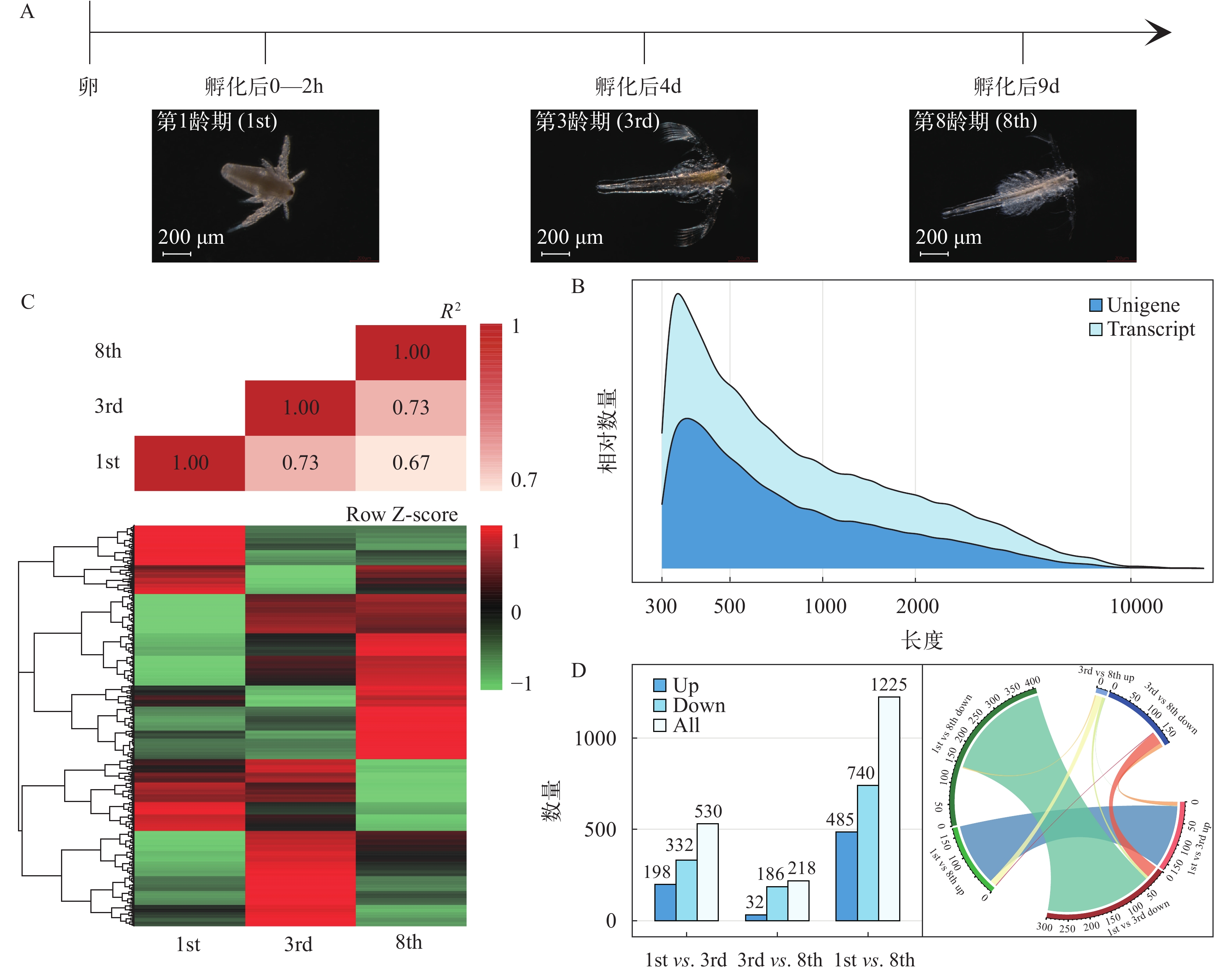
 下载:
下载:
